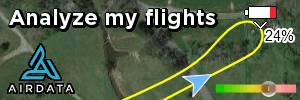You are using an out of date browser. It may not display this or other websites correctly.
You should upgrade or use an alternative browser.
You should upgrade or use an alternative browser.
What do you have your return to flight height set for?
- Thread starter cavenger
- Start date
chuck1026
Well-Known Member
- Joined
- Apr 2, 2017
- Messages
- 205
- Reactions
- 88
- Age
- 59
Depends on where I am. Higher than the tallest obstacleJust curious what others are doing. Thanks.
Not A Speck Of Cereal
Well-Known Member
- Joined
- Apr 26, 2019
- Messages
- 1,470
- Reactions
- 1,226
This is not a set-and-forget configuration.
I mean, go ahead and have a default, but RTH height should be part of every pre-flight check-list. (Just look up from your position and take a quick look to be sure your default is enough).
By contrast, if you had it set for 120m due to one environment (tall obstacles), but are flying in a flat desert the next day, having it rise to 120m is going to be a PITA.
Chris
I mean, go ahead and have a default, but RTH height should be part of every pre-flight check-list. (Just look up from your position and take a quick look to be sure your default is enough).
By contrast, if you had it set for 120m due to one environment (tall obstacles), but are flying in a flat desert the next day, having it rise to 120m is going to be a PITA.
Chris
Last edited:
chuck1026
Well-Known Member
- Joined
- Apr 2, 2017
- Messages
- 205
- Reactions
- 88
- Age
- 59
Great answer. I was lazy when I answered.This is not a set-and-forget configuration.
I mean, go ahead and have a default, but RTH height should be part of ever pre-flight check-list. (Just look up from your position and take a quick look to be sure your default is enough).
By contrast, if you had it set for 120m due to one environment (tall obstacles), but are flying in a flat desert the next day, having it rise to 120m is going to be a PITA.
Chris
thatswedishguy
Well-Known Member
- Joined
- Jan 22, 2019
- Messages
- 96
- Reactions
- 47
As low as possible but still higher than any obstacles that may be a factor, and never above the legal maximum altitude above ground for any path the drone may fly while returning home.
This usually means setting the RTH altitude before taking off at a new location.
This usually means setting the RTH altitude before taking off at a new location.
i have mine set at 40m and i have found it to be a good average starting point for where i mostly fly,as it clears trees and structures at my local sites no problem ,i would always as others have said look around any new sites to see where if any high trees or structures were present and really it is a good idea to do that at any place you fly,its called risk management
paulatkin73
Well-Known Member
Fred Garvin
Well-Known Member
I’m with the others.....it’s set during pre-flight at each location....higher than the tallest obstruction, but not excessively high.
I’ve never used RTH or had the aircraft enter that mode.
I’ve never used RTH or had the aircraft enter that mode.
its important to check you have a setting that suits your location but i like @Fred Garvin always fly back myself, RTH to me is for if an issue happens that causes it to go into RTH and gets it coming home but even then i will cancel it and land myself if i can
Agree... but sometimes I get lazy, or just want to lay down and watch my drone do it.its important to check you have a setting that suits your location but i like @Fred Garvin always fly back myself, RTH to me is for if an issue happens that causes it to go into RTH and gets it coming home but even then i will cancel it and land myself if i can
DavidJL39
Active Member
I usually keep it set at 165 ft subject to a check that therexseems to be nothing near or above that height in the proposed flying area,Just curious what others are doing. Thanks.
I’m in rolling hill and valley country. 200 feet guarantees a collision with terrain . RTH set to the max.
that all depends where you are flying from in relation to the topography and what you need to clear on a RTHI’m in rolling hill and valley country. 200 feet guarantees a collision with terrain . RTH set to the max.
- Joined
- May 25, 2017
- Messages
- 8,476
- Reactions
- 7,966
- Age
- 63
The main reason to have RTH alt set to ‘enough’ is to avoid stronger wind at higher altitude, possible loss of drone being taken away / fighting wind unnecessarily.
Also avoids auto RTH waste of some possibly vital battery going both higher and fighting stronger wind speed.
Also avoids auto RTH waste of some possibly vital battery going both higher and fighting stronger wind speed.
I usually fly from the valley floor. So a lot of the allotted 400 feet is spent just clearing the ridge. When I first got the Mavic I flew it out a mile, haven’t gone half that since. Also have the battery alarms set to 30%. I ‘m not interested in high speed low altitude photography. High, slow and sedate is fine with me. I want to wear this thing out, not crash it.
Hedonist222
Well-Known Member
I realized that the height needst be set every flight.
I realized this the hard way a few days ago.
I lost signal between a rock and a hard place.
Was on a very remote Indonesian jungle island.
The rock being the ocean and the hard place the dense jungle.
Funny thing is that I lost signal from a lateral distance of no more than 100-150 feet and a height of approximately 15 meters.
But the m2p at the time was around a bend. Dense jungle and a rock hill separated us.
This was my first RTH experience and it was absolutely nerve wracking.
The only redeeming element, while waiting for what seemed like an eternity, was that I could see motor RPM and speed (if no not mistaken), which assured me it hadn't crashed.
Moments later we hear it happily descending 1 meter away from the home point.
In retrospect, I should've set the height to at least 70 meters because, not only are the trees tall, some are on a cliff.
Lesson learned.
I realized this the hard way a few days ago.
I lost signal between a rock and a hard place.
Was on a very remote Indonesian jungle island.
The rock being the ocean and the hard place the dense jungle.
Funny thing is that I lost signal from a lateral distance of no more than 100-150 feet and a height of approximately 15 meters.
But the m2p at the time was around a bend. Dense jungle and a rock hill separated us.
This was my first RTH experience and it was absolutely nerve wracking.
The only redeeming element, while waiting for what seemed like an eternity, was that I could see motor RPM and speed (if no not mistaken), which assured me it hadn't crashed.
Moments later we hear it happily descending 1 meter away from the home point.
In retrospect, I should've set the height to at least 70 meters because, not only are the trees tall, some are on a cliff.
Lesson learned.
I recently had a full “down link lost “ event myself, almost a minute of a blank RC and a black phone. But it flew itself home 
paulatkin73
Well-Known Member
yep, it is quite incomprehensible that through all the years DJI refuses to add a usual generic terrain following feature to their code, that most other autopilot software codes got.I’m in rolling hill and valley country. 200 feet guarantees a collision with terrain . RTH set to the max.
- Joined
- May 25, 2017
- Messages
- 8,476
- Reactions
- 7,966
- Age
- 63
I’m in rolling hill and valley country. 200 feet guarantees a collision with terrain . RTH set to the max.
If max alt set is 400’, just remember that extra (say) 150’ to 100’ over safe RTH could put you in higher winds.
Also, if you do have an M2 machine (this thread is about this model), the OA is very good if you do happen to strike (no pun intended) an obstacle of unexpected height in its path while on RTH.
Caution too about RTH into the sun, as this will usually balk the front sensors into thinking that is an obstacle.
Similar threads
- Replies
- 2
- Views
- 536
- Replies
- 16
- Views
- 3K
- Replies
- 6
- Views
- 971
- Replies
- 21
- Views
- 2K
DJI Drone Deals
New Threads
-
4 Pro Night Christmas Boats Parade
- Started by MikeReidPhotography
- Replies: 0
-
-
Mini 5 Pro Mist-erious Forest | West Coast rainforest with Mini 5 Pro & 3 Pro
- Started by DMD Cine Attic
- Replies: 1
-
-
RC Pro 2 cannot record audio when connected to the Air 3S
- Started by Paul Harvey
- Replies: 1
Members online
Total: 3,833 (members: 8, guests: 3,825)










